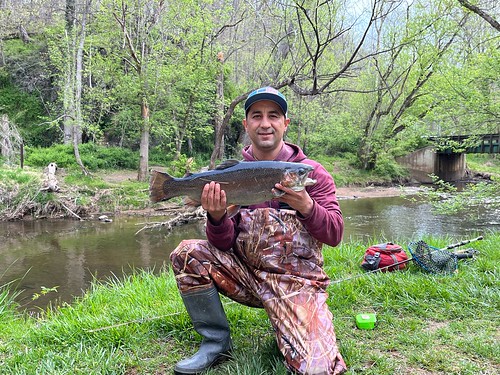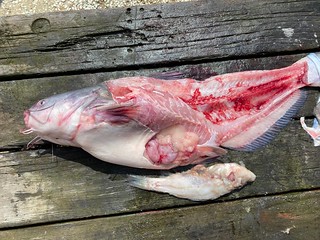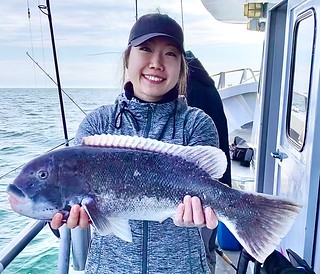
Reza Karimi was fishing Seneca Creek when he caught this trophy-sized rainbow trout. Photo courtesy of Reza Karimi
April has been a wonderful month for fishing, especially for our put-and-take trout anglers. Maryland Department of Natural Resources staff have been out each week stocking trout waters around the state.
The 2022 striped bass trophy season begins Sunday, May 1, and our Chesapeake Bay anglers will be out in force – be sure to check the DNR website for seasonal regulations in your area of the Bay.
Forecast Summary: April 27 – May 3:
Moderate and windy conditions will lead to warmer temperatures for the beginning of striped bass season, and for the shad run going on now and in the next couple of weeks in Maryland lower salinity waters. Chesapeake Bay surface water temperatures have increased several degrees since last week to the upper 50s and low 60s. After several days of this week’s warming temperatures, smaller streams and downwind areas on a sunny day will warm faster and hold water temperatures in the upper 60s.
Expect average flows for most Maryland rivers and streams this week. Expect average water clarity for most of the main Bay and many rivers and streams. Expect reduced water clarity from algal blooms in some rivers including the Bush, Gunpowder, Back, upper Chester, upper Choptank, upper Nanticoke, and middle Potomac River from the Route 301 bridge down to Leonardtown. To see the latest water clarity conditions, check Eyes on the Bay Satellite Maps on the Maryland Department of Natural Resources website.
There will be above average tidal currents Wednesday and Thursday as a result of the new moon on May 1.
As always, best fishing areas could be further refined by intersecting them with underwater points, hard bottom, drop-offs, and large schools of baitfish.
For more detailed and up-to-date fishing conditions in your area of the Bay, be sure to check out Eyes on the Bay’s Click Before You Cast.
Upper Chesapeake Bay

Tim Campbell holds up a hickory shad before releasing it back into the lower Susquehanna. Photo courtesy of Tim Campbell
Anglers searching for hickory shad in the lower Susquehanna River, Deer Creek, and Octoraro Creek have experienced good days when the sun shined brightly and creek waters warmed. The hickory shad runs are so reliant on water temperature, it can be hard to judge and plan a trip. Despite cloudy water conditions in the river, anglers are picking away at hickory shad. There have been a few reports of American shad in the Conowingo Dam pool and in the river just below it.
Most anglers are fishing at the mouths of Deer Creek and Octoraro Creek using a combination of a small shad dart and a small gold or silver spoon in tandem. Gold spoons tend to work best in cloudy water conditions and silver when the sun is bright and waters clearer. White and red shad darts are always popular but on some days pink, yellow, gold, or chartreuse will stand out. It always pays to have a variety of colors and weights since many anglers have to drive a distance to experience this catch-and-release fishery.
Anglers are predominantly targeting blue catfish, since they can be found in almost every part of the upper Bay and many are fairly large. Channel catfish will often be part of the mix. It is a simple type of fishing – stout tackle, a simple sinker and circle hook rig baited with fresh cut bait of menhaden, gizzard shad, chicken liver or breast, clam snouts, or other personal concoctions.
Catfish are not all that hard to clean, you just need a pair of fish-skinning pliers – regular pliers out of your tool box will have a tough time gripping the skin once they get gummed up. Simple cuts that you perform when fileting any fish are made and the skin is pulled off. Some will drive a large spike through the head of the catfish to hold it fast but it is not too difficult to grasp the catfish behind the head. You can cook the filet as it is, or enjoy the mild flavor that occurs when all of the silver skin and red meat is removed. Catfish nuggets and hush puppies are pretty hard to beat on anyone’s menu.
Fishing for white perch in the upper Bay’s tidal rivers is popular this week. The white perch have moved to the middle and lower river sections. Fishing with bottom rigs baited with grass shrimp or pieces of bloodworm are the most popular way to fish. Another option is fishing with small jigs tipped with grass shrimp or pieces of bloodworm.
Fishing for northern snakeheads is improving as warmer water temperatures cause the fish to be more active. Snakeheads can be found in every tidal river and creek in the upper Bay and the Susquehanna Flats. Casting white paddle tails and frogs are popular ways to fish for them. Rigging a lip-hooked large minnow under a bobber can work well.
The 2022 spring trophy striped bass season opens May 1, and upper Bay anglers need to remember that they can only fish for striped bass below the Brewerton Channel. The 2022 striped bass regulations are on the DNR website.
Trolling large bucktails and parachutes along the shipping channel edges near Podickory Point, the Dumping Grounds and near the Bay Bridge will be popular. The minimum size for fish to be kept is 35 inches, with a limit of one fish per angler per day. Anyone deciding to chum or chunk for striped bass must use non-offset circle hooks, fishing with live eels is not allowed. The rip at Sandy Point State Park and the Matapeake Fishing Pier will be popular places to fish bait for shore bound anglers.
Middle Bay

This recently caught Choptank blue catfish had an 11-inch white perch in its stomach. Photo by Keith Lockwood
Striped bass anglers in the middle Bay are reminded that when trophy season opens May 1, striped bass fishing is only allowed in the main stem of the Bay; the tidal rivers are still closed to fishing.
The bulk of the striped bass spawning in the Choptank River has occurred and those post spawn fish will be exiting the river. A few good places to try and intercept them will be the steep channel edges at the False Channel, RN2, and the steep channel edge south to the CP Buoy. Of course there is no set pattern to where they may travel once they leave the Choptank and they will be hungry and on the prowl for schools of menhaden. The steep channel edges near Bloody Point, Buoy 83, and the western shore shipping channel edges from Thomas Point south past Breezy Point are always good places to troll.
Large parachutes and bucktails dressed with equally large sassy shads will be the most popular trolling lures to use in tandem or behind umbrella rigs; heavy inline weights will get the baits down deep, and unweighted tandem rigs will cover the top waters. At first light it is common for the large striped bass to be close to the surface, but boat traffic will soon drive them deep. Outboard planer boards with an array of lines spread out make turning difficult, so those who are new to this game need to notice the trolling patterns of the charter boats and follow suit. You don’t want to meet another boat trolling at a 90-degree angle.
Some anglers will choose to light-tackle jig at places they can spot fish suspended near channel edges. The warm water discharge plume at the Calvert Cliffs Power Plant will be a popular place to jig. Large soft plastic jigs will be a popular choice. A few might choose to chum or chunk for their striped bass, just remember to use non-offset circle hooks.
Fishing for blue catfish will offer some distraction from striped bass for anglers working the tidal rivers. There are plenty of blue catfish in the Choptank River and they offer good action and good eating. Using circle hooks are the best option when fishing with bait in the tidal rivers. Cut menhaden or gizzard shad are excellent baits, while chicken liver, breast meat or clam snouts can also work well. The population of blue catfish is exploding in the Choptank River and catching them should be a focus for anglers who care about species such as white perch and young striped bass, whose populations can be seriously affected by these invasive catfish.
White perch have moved down to the middle and lower sections of the region’s tidal rivers. Bottom rigs baited with grass shrimp or pieces of bloodworm are working the best in deeper waters, especially when fishing from shore. Small jigs tipped with grass shrimp or pieces of bloodworm can work also when fishing near structure, docks, and piers.
Lower Bay

Gene Wright and Eric Packard heft up a stringer of blue catfish from the Fort Washington area of the Potomac. Photo courtesy of Eric Packard
Striped bass trophy season begins May 1, and the lower Bay consistently offers some of the best opportunities to connect with a trophy-sized fish. Trolling along the steep edges of the shipping channel with large parachutes and bucktails dressed with large sassy shads. Planer boards will help deploy a wide trolling spread along with a few flat lines.
Traditional areas to troll are the channel edges at Cove Point, Cedar Point, Point No Point, and Smith Point on the western side of the bay. On the eastern side, areas include the steep channel edges from the CP Buoy south to Buoy 76, 72B, and the main channel down the center of Tangier Sound. In the lower Potomac River, the steep channel edge from Piney Point to St. Georges Island and Point Lookout are traditionally good places to check.
The early bird gets the worm, or in this case, the striped bass swimming close to the surface, although boat traffic will drive them to the depths quickly. Surface water temperatures are warmer than deeper waters so it is often a preferred space for striped bass.
Fishing for blue catfish in the tidal rivers has been a great sidebar for anglers during the closed striped bass season. Blue cats will continue to offer fun fishing in the tidal rivers, and anglers can participate in a conservation effort to help diminish this invasive fish and their predatory effects on native fish populations.
Northern snakeheads are another invasive fish that has spread across every tidal river in Maryland. This is an aggressive predator on native fish populations – and most anything that moves and will fit in their mouth. The tributaries to the Potomac River tend to hold some of the largest concentrations of snakeheads. The upper Patuxent River and the rivers and creeks of southern Dorchester County on the Eastern Shore are a close second. Lately anglers have been having good luck casting frogs over patches of grass, and white paddle tails rigged weedless are always a popular bait. A large minnow rigged under a bobber is also a good tactic, especially when casting lures from a boat or kayak in relatively open water.
Freshwater Fishing

Denise Wissinger holds a beautiful smallmouth bass before slipping it back into the river. Photo by Scott Wissinger
Anglers at Deep Creek Lake are seeing water temperatures get slowly warmer. Northern pike are seeking the warmer waters of the coves and can be found holding at the mouths; casting large spinnerbaits and jerkbaits are good ways to target them. Largemouth bass are staging on the points leading to many of the shallower coves, and perhaps by early next month the males will be fanning out spawning beds to attract the females. Floating docks are being deployed every week and they make good cover to attract largemouth and smallmouth bass. Walleye tend to be holding along rocky shores in depths below 10 feet, and can be caught with small crankbaits and live minnows.
The upper Potomac water levels are slowly returning to acceptable fishing conditions and water temperatures are holding in the lower 60s. Fishing the current breaks and deep ledges is a good tactic with soft plastic baits and small crankbaits.
In the central, southern, and eastern regions of the state, largemouth bass are close to spawning or already started. Small ponds usually have the warmest water, followed by larger bodies of water and tidal rivers and creeks. The males have carved out spawning beds in the shallow areas and the females are either on the beds or staged nearby in slightly deeper water. Targeting the largemouth bass that are holding in the deeper waters can be accomplished with small crankbaits, spinnerbaits, jerkbaits, and soft plastics. Any kind of structure such as sunken wood or deep grass are good places to target.
Fishing for crappie is very good this week; the cooler water temperatures allow the crappie to freely move in a variety of water depths. Structure is often the key – fallen treetops, sunken wood and brush, or marina docks are good places to look for crappie. Small marabou jigs or minnows under slip bobber are excellent ways to fish or just casting jigs with a very slow retrieve.
Atlantic Ocean and Coastal Bays

Photo by Monty Hawkins
Surfcasters are catching black drum this week, although the numbers are down from two weeks ago. Clearnose skates continue to be pesky bait stealers, with a few dogfish also added to the mix. Sand fleas have been the most popular bait, but a few anglers are also using bloodworms and clams to catch an occasional striped bass, which mostly fail to meet the 28-inch minimum.
Tautog are being caught on sand leas along the inlet jetties, the Route 50 Bridge piers, and nearby bulkheads. Many fall short of the 16-inch minimum but most anglers are able to take home a few legal-sized fish. Flounder are also being caught in the inlet and Route 50 Bridge area and the channels leading from the inlet. The channels in Assawoman Bay and Sinepuxent Bay also provide good flounder fishing opportunities when the water conditions are clear. Soft plastics such as Gulps are catching many of the flounder as well as squid strips and minnows.
Offshore tautog fishing is the most popular fishery at the offshore wreck and reef sites. The wind tends to dictate when boats can take anglers out to fish, but when conditions are favorable some rather large tautog are being caught.
The streams that hold trout are filled with spirits. They are filled with magic that will stay as long as someone comes to feel it. When we come upon old gear that has been well made and well cared for, we can feel the spirits in that, too. As long as we appreciate these things, and as long as we seek out and worship at the magic places, they and we will live forever.” — Cliff Hauptman
Maryland Fishing Report is written and compiled by Keith Lockwood, fisheries biologist with the Maryland Department of Natural Resources.
Click Before You Cast is written by Tidewater Ecosystem Assessment Director Tom Parham.
This report is now available on your Amazon Echo device — just ask Alexa to “open Maryland Fishing Report.”
